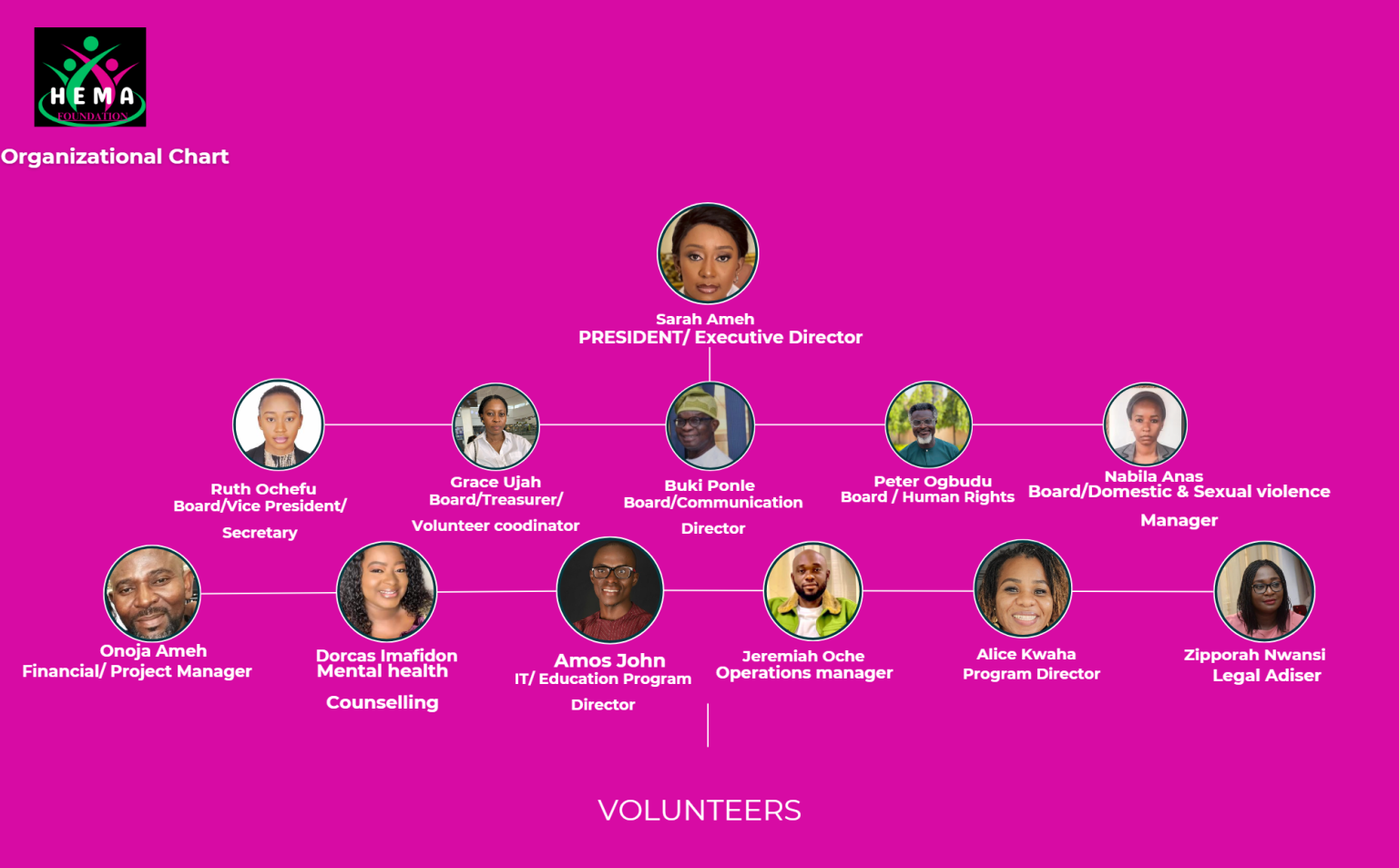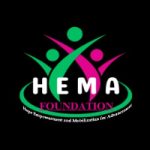HEMA Foundation Structure

Structure of HEMA Foundation for Gender Equality, Climate Change Mitigation, and Persons with Disabilities
1. Leadership and Governance
*President and Founder: Sarah (Oversees strategic direction and operations of the foundation).
*Board of Directors: A diverse group with expertise in gender equality, climate change, and disability advocacy.
– Advisory Board: Experts in human rights, environmental science, disability inclusion, and legal frameworks, providing strategic advice.
2. Core Departments
a. Gender Equality and Women’s Empowerment
– Gender Advocacy and Policy Unit:
– Focuses on advocating for gender-inclusive policies, legislative changes, and capacity building for women and young girls.
– Collaborates with governmental bodies and NGOs to address gender disparities.
– Skills Development and Economic Empowerment:
– Provides training and vocational programs to empower women, focusing on economic independence.
– Offers entrepreneurial support and mentorship to women-led initiatives.
– Education and Awareness:
– Runs campaigns to educate communities on gender equality, addressing harmful gender norms and stereotypes.
– Engages community leaders and educators to ensure inclusivity in educational programs.
b. Climate Change Mitigation and Environmental Sustainability
– Climate Action and Advocacy Unit:
– Advocates for climate policies that integrate gender considerations and prioritize vulnerable populations, including persons with disabilities.
– Collaborates with national and international environmental organizations.
– Sustainability and Green Initiatives:
– Focuses on sustainable practices in agriculture, waste management, and renewable energy, particularly benefiting women in rural areas.
– Engages communities in tree-planting drives, clean energy projects, and water conservation efforts.
– Climate Education and Adaptation Programs:
– Develop climate education programs targeting schools, women’s groups, and communities.
– Provides training on climate resilience and adaptation, equipping women and persons with disabilities with knowledge on environmental challenges.
c. Disability Inclusion and Empowerment
– Disability Rights and Advocacy Unit:
– Advocates for the rights of persons with disabilities, ensuring their inclusion in social, economic, and political life.
– Promotes policies that remove barriers to education, employment, and healthcare for persons with disabilities.
– Accessibility and Inclusion Programs:
– Provides training and support to improve accessibility in schools, public spaces, and workplaces.
– Works with local governments and businesses to ensure compliance with accessibility standards.
– Disability Support Services:
– Offers assistive devices, mobility aids, and access to specialized healthcare for persons with disabilities.
– Conducts capacity-building workshops focused on enhancing the skills and independence of persons with disabilities.
3. Community Engagement and Volunteer Network
– Volunteer Programs:
– Includes volunteers like Grace Ujah, contributing expertise in fire safety and health, as well as volunteers who assist with environmental and disability-related activities.
– Builds peer-to-peer mentoring networks for women and persons with disabilities.
– Community Outreach:
– Implements gender-responsive and disability-inclusive outreach programs in rural areas, offering support, resources, and training.
– Collaborates with local leaders and grassroots organizations to ensure accessibility and inclusivity.
4. Funding and Partnerships
– Partnerships with NGOs and Government Bodies:
– Collaborates with international and regional bodies working on gender equality, climate change, and disability rights.
– Build partnerships with environmental NGOs to enhance climate-related initiatives.
– Corporate Social Responsibility (CSR) Programs:
– Works with businesses to fund gender, climate change, and disability programs through CSR efforts.
– Grants and Donations:
– Seeks grants and donations from global foundations, emphasizing intersectional solutions for gender, climate, and disability challenges.
5. Research, Policy, and Innovation
– Gender and Climate Research Division:
– Conducts research on the intersection between gender, climate change, and disability inclusion.
– Analyzes data to develop targeted strategies for community adaptation and resilience.
– Collaborates with experts like Ruth Ehi Ochefu, utilizing IT solutions to track progress in empowerment and environmental initiatives.
– Innovation for Inclusion Program:
– Promotes the use of technology and innovative solutions for improving accessibility and climate resilience.
– Develops tech-driven platforms to enable persons with disabilities to access resources, training, and support.
6. Monitoring, Evaluation, and Learning (MEL)
– Impact Evaluation Team:
– Regularly assesses the foundation’s impact on gender equality, climate resilience, and disability inclusion.
– Uses data-driven tools to monitor program success and adjust strategies based on feedback and outcomes.
– Reporting and Accountability:
– Ensures transparency and accountability by providing detailed reports to stakeholders, donors, and the public.
7. Global and Regional Networks
– International Collaboration:
– Engages with global networks focused on gender equality, climate change, and disability rights, ensuring that HEMA Foundation’s work is informed by best practices.
– Regional Focus:
– Tailors programs to address specific challenges within various regions across Africa, incorporating local customs, climate conditions, and cultural attitudes toward gender and disability.

